Last Updated on January 18, 2024 by Greg Gillson
Did you see a brightly-colored red bird, orange bird, or yellow bird in New Mexico and wonder what it was?
This page is for you!
This article shows you photos and identification of some of the most common birds in New Mexico based on color.
The list of birds found in New Mexico includes over 560 species. So, I can’t show you all of them. I’m going to assume that you saw a common bird of this color, but you certainly could have seen something less common, or even rare!
Shape (including the shape of the bill) and size are often more helpful in starting to identify a bird than the color. In fact, most birds in North American can be easily identified with a black-and-white photo!
Many birds are multi-colored, so that it may be hard to pick out a dominant color. Males and females may be colored quite differently. And some color patterns are similar among otherwise dissimilar species.
Nevertheless, I’m going to try to pick out some of the birds that you are most likely to see in backyards or towns. And I’ll show a few others that I get asked about a lot.
The birds with a noticeable amount of red on them in New Mexico covered in this article are:
- House Finch
- American Robin
- Broad-tailed Hummingbird
- Summer Tanager
- Pyrrhuloxia
The birds with a noticeable amount of orange on them in New Mexico covered in this article are:
- Rufous Hummingbird
- Northern Flicker
- Spotted Towhee
- Barn Swallow
- American Kestrel
- Cooper’s Hawk
- Black-headed Grosbeak
- Ruddy Duck
- Bullock’s Oriole
The birds with a noticeable amount of yellow on them, including lots of yellow and black birds, in New Mexico covered in this article are:
- Lesser Goldfinch
- American Goldfinch
- Yellow-rumped Warbler
- Pine Siskin
- Western Kingbird
- Cassin’s Kingbird
- Western Meadowlark
- Western Tanager
- Wilson’s Warbler
- Yellow Warbler
- Yellow-breasted Chat
- Common Yellowthroat
Red birds of New Mexico
Birds get the red, orange, and yellow in their feathers from carotenoids in the fruit, seeds, and plants they eat (source).
These carotenoid colors combine with melanin to form an infinite range of red feathers–pink, rusty, scarlet, violet, red-orange.
The following are red birds that you are most likely to see in New Mexico.
House Finch
When people ask about a bird with a red head at their feeder, it is usually this bird.
 |
| Male House Finch. Greg Gillson. |
Males of this dusty brown striped finch have red limited to the head (specifically the forehead and eyebrow), breast (chest), and rump. The red coloration tends toward orangish and may rarely be yellowish.
Females are streaked, similar to the males but without red. They lack any strong pattern on the face and head.
Note the small round head and curved upper ridge on the bill.
Some people call these red-headed sparrows. Sparrows and finches are similar, but in general, male finches are brighter than the females and tend to hang out more in trees. Sparrow genders are usually quite similar in coloration and tend to feed mostly on the ground.
These birds are common in residential areas, especially at bird feeders. In the West more widespread in arid regions near water.
House Finches are year-round residents throughout New Mexico.
American Robin
These are familiar lawn birds with red breasts.
 |
| American Robin. Greg Gillson. |
Male American Robins are brownish-gray above with a brick red breast. Females are paler orange below and paler gray above.
They are widespread in open country with scattered deciduous trees, residential areas.
American Robins are year-round residents through most of New Mexico, winter visitors only in southwestern New Mexico.
Broad-tailed Hummingbird
These hummingbirds of the mountain West have rosy-red throats.
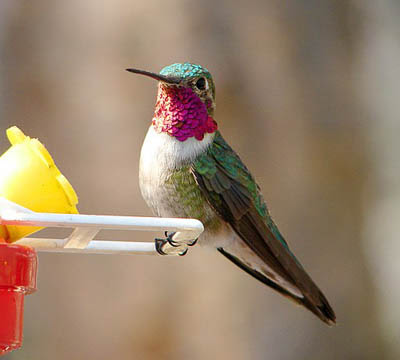 |
| Broad-tailed Hummingbird. Michelle Lynn Reynolds. CC BY-SA 3.0 |
Both genders are green above, white below, with green and buff flanks. Rusty bases to outer tail feathers.
Males have bright red throats.
Found in dry pine and montane forests.
Broad-tailed Hummingbirds are summer residents in isolated mountains throughout New Mexico.
Summer Tanager
These bright red birds are found toward the tops of tall trees in the southern United States.

Males are rose red with fairly heavy bill.
Females are yellowish or mustard-colored, some with a faint reddish wash.
In the East these birds are found in pine-oak woodlands. In the West they prefer tall cottonwood trees.
Summer Tanagers are summer residents in northern and southern New Mexico and in parts of central New Mexico.
Pyrrhuloxia
These gray and red desert birds are shaped like cardinals, to which they are related.
 |
| Pyrrhuloxia. Uploaded by berichard, CC BY 2.0, Link |
Males are pale gray with red highlights on face, crest, and chest.
Females are gray and buff-colored, with only a hint of red. The bill is yellowish and strongly curved on the culmen (upper ridge).
These birds are found in thorny desert scrub, such as mesquite, and also ranches.
Pyrrhuloxias are year-round residents in southern New Mexico.
Orange birds of New Mexico
True orange-colored birds are not that common. Many birds that I have here are paler rusty.
The common pattern is an orange body and black or brown wings and tail. Another common pattern is for the orange to be restricted to the under parts.
The following are orange birds that you are most likely to see in New Mexico.
Rufous Hummingbird
These are the common widespread hummingbirds of the Pacific Northwest and Alaska. These orange birds don’t like to share the hummingbird feeder–frequent chases are the norm.
 |
| Rufous Hummingbird. Greg Gillson. |
Males are all-over rusty orange, tending to pinker cinnamon on the under parts. Even the back and rump and base of the tail feathers are orange. Males have a bright red throat gorget when the sunlight catches it just right.
Females are green above, with a small green or red spot in the center of the white throat. Flanks and sides cinnamon. Tail base orange.
These birds are found in forest edges, yards, in all but the highest mountains.
Rufous Hummingbirds are fall migrants throughout New Mexico.
Northern Flicker
These unusual woodpeckers with orange under wings are just as likely to be found hopping on your lawn eating ants as they are to be calling from a dead tree top.
 |
| Northern Flicker. Greg Gillson. |
Where is the orange color?
Wait for it…
 |
| Northern Flicker. Greg Gillson. |
The shafts and undersides of the wing and tail feathers are a salmon orange color. A large white rump patch also attracts attention as these birds fly away.
Northern Flickers live in open woods, residential areas. Sometimes visit feeders in winter.
Northern Flickers are year-round residents throughout most of New Mexico, winter visitors only in southeastern New Mexico.
Spotted Towhee
These big sparrows with red sides superficially resemble the coloration of robins.
 |
| Spotted Towhee. Greg Gillson. |
These birds have dark hoods and upper parts with rusty rufous-red sides and white bellies. They have white spots over their wings, shoulders, and on their tail corners. The upper parts of the males are jet black, females dark brown. Some populations have paler orange sides.
These are somewhat shy birds that hide in the dense brush and spend most of their time on the ground. They visit feeders during quiet periods.
Spotted Towhees are year-round residents throughout most of New Mexico.
Barn Swallow
These orange-bellied birds are a familiar sight across North America in summer.
 |
| Barn Swallow. Greg Gillson. |
These birds are purple-blue above with orange under parts and long forked tails. The color of the underparts in winter or on females are often cinnamon or buff-colored, but breeding males can be brighter orange-red.
These birds swoop low over fields and wetlands at lower elevations. They may build their mud nests in rafters on porches, garages, or other out-buildings.
Barn Swallows are summer residents throughout New Mexico.
American Kestrel
These are the familiar small rusty-orange falcons sitting on power lines on the edge of the highway, or hunting and hovering over the median strip.
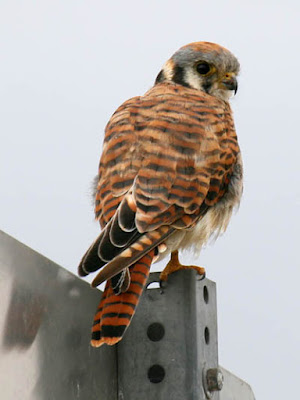 |
| Female American Kestrel. Greg Gillson. |
Females are rusty orange barred with black on their back wings and tail. The under parts are buff with black spots. The head shows two facial stripes.
Males have blue-gray backs and rufous tail is unmarked except for black tail band.
These birds are found in open country, farms, pastures with perches.
American Kestrels are year-round residents throughout New Mexico.
Cooper’s Hawk
These crow-sized hawks with reddish orange bars on the under parts may show up in fall or winter to hunt birds at your feeder. Oh no!
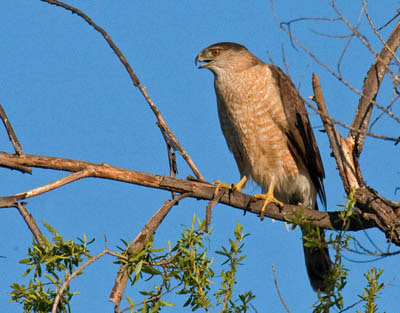 |
| Cooper’s Hawk. Greg Gillson. |
Adults with long gray and black banded tail. Dark gray above and cap on head. Under parts barred with rusty orange.
Immatures similar, brownish, streaked with brown on under parts.
Found in forests and woodlands, residential shade trees.
Cooper’s Hawks are year-round residents throughout New Mexico.
Black-headed Grosbeak
If you didn’t look closely at these big-billed birds, you might mistake these orange-breasted songsters for American Robins–their coloration and song are very similar!
 |
| Male Black-headed Grosbeak. Greg Gillson. |
Males have black and white wings and tail. Huge bill. The under parts are burnt orange, fading to yellow-orange mid-belly.
Females and first year birds have a striped heads and are brown above, pale buff or butterscotch-orange below.
These birds are found in deciduous or mixed woods. Visit bird feeders.
Black-headed Grosbeaks are summer residents throughout most of New Mexico, spring and fall migrants only in eastern New Mexico.
Ruddy Duck
These small ducks are dark rusty-orange in spring.
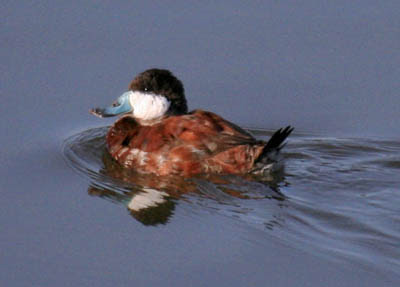 |
| Ruddy Duck. Greg Gillson. |
Males in breeding plumage (late winter and spring) are rusty, with a white face, and a blue bill. The long tail is often held sticking up. In winter they are brown, with white face, and dark bill.
Females all year are like winter males. Brown body, dark cap, dark line through eye of pale face. Dark bill.
These birds prefer weedy ponds to breed, but in winter may be found in deeper ponds in city parks.
Ruddy Ducks are summer residents throughout most of New Mexico, year-round residents in central and southwestern New Mexico, winter visitors only in southeastern New Mexico.
Bullock’s Oriole
These bright orange and black birds are often seen in tall trees.
 |
| Male Bullock’s Oriole. Greg Gillson. |
The males of this species are very bright orange. The back and top of the heads are black. The black wings have large white wing patches. The tail is black with orange sides. The face is orange with a black line through the eye and a black throat.
Females and young are gray with yellow head and breast and tail.
These birds are more common in drier inland regions along watercourses in tall cottonwoods or shade trees. Rarely come to feeders for fruit or nectar in spring.
Bullock’s Orioles are summer residents throughout New Mexico.
Yellow birds of New Mexico
Yellow is a common bird color! Often it is mixed with black and white plumage in birds.
Many birds with darker upper parts have yellow breast or belly.
The following are yellow birds you are most likely to see in New Mexico.
Lesser Goldfinch
Lesser Goldfinches maintain their bright yellowplumage all year–even in the winter when American Goldfinches are rather brown and colorless.
 |
| Male Lesser Goldfinch. Greg Gillson. |
These tiny birds are bright yellow below (including under the tail), and green or black on the back. The wings and tail are black and white. Males have a black cap, which the females lack.
These birds are found near water in arid regions of the West and Southwest. They are common in residential areas, too, and come to bird feeders.
Lesser Goldfinches are summer residents throughout New Mexico, year-round residents in southern New Mexico.
American Goldfinch
These small little birds are bright yellow and black.
 |
| American Goldfinch. Greg Gillson. |
Males are bright lemon yellow with black and white wings and tail, black cap. White under tail coverts. Pink bill.
Females are duller yellow below and brownish above. Lack black cap.
Winter birds are pale brown or gray, a touch of yellow on the throat of males.
These are birds of open country, fields with saplings, clear cuts, residential areas. They avoid dense forests, mountains, deserts. They visit feeders.
American Goldfinches are winter visitors throughout New Mexico.
Yellow-rumped Warbler
These are abundant warblers across North America. Affectionately called “butter butts” by many birders, because of their bright yellow rumps that flash in flight.
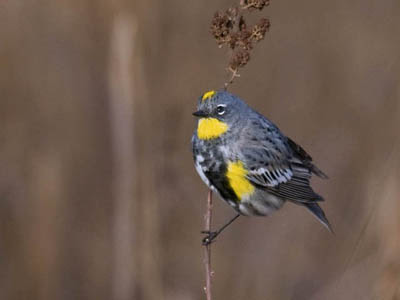 |
| Male Audubon’s Yellow-rumped Warbler. Greg Gillson. |
Western form (Audubon’s) with bright yellow throat and yellow rump. Large white wing patch.
Northern and Eastern form (Myrtle) with white throat, yellow rump, and two white wing bars.
Winter birds are dull gray brown, with bright yellow rump. Throat may be cream colored or white. Often difficult to tell the two forms apart in winter.
 |
| Winter Yellow-rumped Warbler. Greg Gillson. |
Breed in mountain or boreal conifers. Widespread in migration. Winter in low river bottoms, open weedy deciduous areas. Rarely come to feeders in winter.
Yellow-rumped Warblers are summer residents throughout most of New Mexico, year-round residents in most of southern New Mexico, spring and fall migrants only in northeastern New Mexico, winter visitors only in southeastern New Mexico.
Pine Siskin
These small brown-streaked birds are relatives of the goldfinches. But you would never know it until they fly and sport yellow wing stripes and tail base. Usually in flocks.
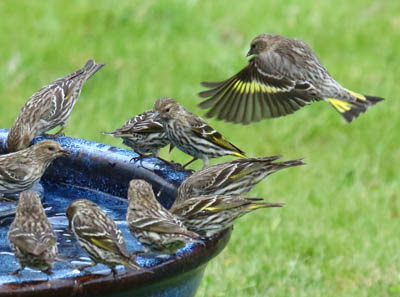 |
| Pine Siskin. Greg Gillson. |
These birds are streaked brown. In flight they have a yellow stripe down the length of the wing. The sides of the base of the tail is also yellow. Some birds are paler, some darker, others brighter yellow, others duller.
These birds are found in summer in northern conifer woods. Irregularly irrupt hundreds of miles southward. Frequent at feeders.
Pine Siskins are winter visitors throughout New Mexico, year-round residents in mountains of western New Mexico.
Western Kingbird
These yellow-bellied birds of the prairies often perch on power lines and fence lines.
 |
| Western Kingbird. Greg Gillson. |
These birds are pale gray on the head and breast. Brown wings. The belly is lemon yellow. Black tail has white outer tail feathers, especially obvious in flight.
These are birds of prairies, deserts, pastures, often near water.
Western Kingbirds are summer residents throughout New Mexico.
Cassin’s Kingbird
These noisy yellow-bellied flycatchers of the Southwest are similar to the more widespread Western Kingbirds.
 |
| Cassin’s Kingbird. Greg Gillson. |
These large-headed birds sit upright. The head is dark gray with sharply-defined white throat. The belly is yellow. The dark brown tail has an indistinct pale tip.
These birds inhabit a wide variety of habitats. They usually include tall trees and open spaces in their home ranges. Open woods, canyons, and parks all suit these birds.
Cassin’s Kingbirds are summer residents in northern, central, western, and southwestern New Mexico.
Western Meadowlark
These are streaky camouflaged prairie birds from above or from behind. But from the front, the breast is shocking yellow!
 |
| Western Meadowlark. Greg Gillson. |
They are streaked brown, black, and gray on the upper parts. The underparts are golden yellow with a black necklace crossing the upper breast. Much paler yellow in fall and winter, as the yellow feathers are tipped with white and streaked with brown.
These are birds of pastures and grasslands and arid regions.
Western Meadowlarks are year-round residents throughout New Mexico.
Western Tanager
Numbers of these bright black and yellow birds may show up overnight in backyards in spring migration. Then they disappear the next night.
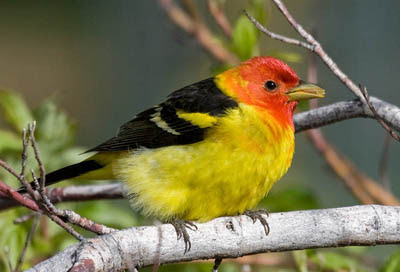 |
| Western Tanager. Greg Gillson. |
Males are brilliant golden yellow with black back, wings, and tail, and a red or orange face. Swollen yellow bill.
Females are more green or gray, with darker wings and tail. Lack red face.
They are found in a variety of wooded habitats, usually conifers or mixed conifer woods, and residential areas with large trees, including mature conifers. Usually don’t visit feeders.
Western Tanagers are summer residents in most of New Mexico, spring and fall migrants only in eastern New Mexico.
Wilson’s Warbler
These bright yellow birds are very common, both on their summer territories and in migration.
 |
| Male Wilson’s Warbler. Greg Gillson. |
These birds are bright yellow in the West, more greenish above in the East. Only males have the black cap.
Both genders have a beady black eye in the middle of the yellow face.
These birds live in damp understory, tangles, willows.
Wilson’s Warblers are spring and fall migrants throughout New Mexico, they are summer residents in a tiny area of northcentral New Mexico.
Yellow Warbler
The golden yellow sun packed all into one little bird! Appears to be an all-yellow bird.
 |
| Yellow Warbler. Greg Gillson. |
Some populations are bright yellow, some tend toward greenish on upper parts, some more golden. Yellow internal tail corners in flight.
Males with red breast streaking, again, variable by population.
Females somewhat to much paler yellow, some greenish, some whitish. Lack red streaks.
These birds are found in willow thickets on the edge of wetlands and ditches, stream sides in arid regions.
Yellow Warblers are summer residents in northern and western New Mexico, spring and fall migrants only in central and southeastern New Mexico.
Yellow-breasted Chat
These unique larger yellow birds may sing day and night, and include whistles and crow-like cawing, often given in a display flight.
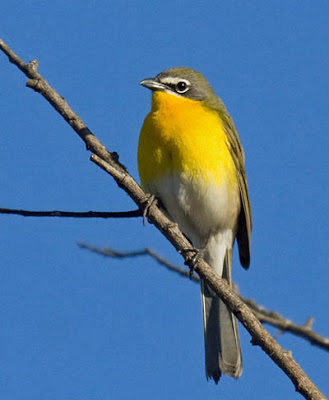 |
| Yellow-breasted Chat. Greg Gillson. |
These birds are greenish above with bright yellow breast and white belly. They have a dark mask bordered with white.
These birds live in tangles and wet woods.
Yellow-breasted Chats are summer residents throughout most of New Mexico.
Common Yellowthroat
These buttery yellow birds are abundant in the marsh vegetation.
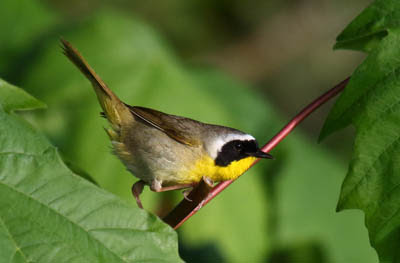 |
| Male Common Yellowthroat. Greg Gillson. |
These skulkers have bright yellow throats and yellow undertail coverts. Males have a black domino mask edged broadly in white, which females lack. Upperparts are dull olive-green.
Immature males in fall show a shadowed black mask.
Found in damp situations and heavy deciduous brambles following clear cuts.
Common Yellowthroats are summer residents in a narrow band from south to north through the middle of New Mexico. They are summer residents in northwestern and northeastern New Mexico, spring and fall migrants through eastern New Mexico.
Wrapping Up
New Mexico boasts a stunning array of colorful birds, each adding a vibrant splash to the diverse landscapes of the state. Here are some more of the most captivating feathered jewels you might encounter:
Painted Bunting: Often called the “Cardinal of the West,” males in this species sport a vivid blue head, red breast, green back, and yellow belly. Females exhibit a more subdued palette but are still quite charming. Look for them in grasslands, shrublands, and open woodlands.
Pinyon Jay: These social birds wear a striking turquoise blue coat with bold black markings and a white wing patch. They flock together in noisy groups, flitting through piñon-juniper woodlands and adding a lively presence to the arid landscapes.
Greater Roadrunner: This quirky long-legged bird sports a rufous brown body, a long black tail, and a crest of feathers on its head. They’re ground-dwellers, known for their impressive running speed and their habit of “roadrunning” along open paths.
Northern Flicker: This woodpecker exhibits a unique combination of colors, with a yellow body, barred black and white back, red nape patch, and black crescent under its eyes. They frequent diverse habitats, drumming on trees and searching for insects under the bark.
Common Raven: While not technically colorful in the typical sense, ravens deserve a mention for their majestic presence. Their glossy black plumage, large size, and intelligent gaze add a touch of mystery and drama to the mountains and desert plains.
Frequently Asked Questions
What is the bright red bird in southern New Mexico?
The Pyrrhuloxia, often nicknamed the “Desert Cardinal” for its vibrant red plumage, adds a splash of color to the arid landscapes of southeastern New Mexico. Here are some tips to help you track down these feathered friends:
Habitat Hotspots:
- Chihuahuan Desert: The Pyrrhuloxia thrives in the arid scrublands and rocky canyons of the Chihuahuan Desert. Look for them in areas with mesquite, creosote bushes, and yuccas.
- Canyons and Foothills: Explore dry streambeds, rocky slopes, and foothills, especially near water sources like springs or seeps. These areas offer both food and shelter for the birds.
- Parks and Preserves: Several parks and preserves in southeastern New Mexico provide excellent opportunities to spot Pyrrhuloxias. Consider visiting places like:
- White Sands National Park: Look for them along the dunes and in the Chihuahuan Desert vegetation around the Alkali Flats Trail.
- Guadalupe Mountains National Park: Head to the foothills and canyons, particularly around McKittrick Ridge and Pine Springs Campground.
- Organ Mountains-Desert Peaks National Monument: Explore the desert slopes and canyons, especially around Dripping Springs Trail and Baylor Pass Trail.
Are Orioles in New Mexico?
Yes, some species of Orioles are indeed found in New Mexico! Depending on the time of year and specific location, you might encounter these colorful songbirds. Here’s a breakdown:
Summer Residents:
- Bullock’s Oriole: The most common Oriole in New Mexico, these beauties arrive in April and stay until September. They favor lowland areas with cottonwoods, willows, and sycamores, building their hanging nests in these trees. You’ll recognize them by their black head and bib, orange throat and belly, and white wing bars.
- Scott’s Oriole: Found primarily in the southeastern part of the state, these Orioles prefer yucca plants and mesquite trees. They sport a black mask and bib, yellow body, and white wing bars. You’re most likely to spot them from May to July.
Migrant Orioles:
- Hooded Oriole: Although not common, these striking birds with black heads and bright yellow bodies can be seen during migration periods (spring and fall) in southern New Mexico, especially near riparian areas.
- Baltimore Oriole: Another occasional visitor, these Orioles sport orange and black plumage and may be spotted during migration, particularly in the eastern part of the state.
What kind of bird has a yellow belly in NM?
The Western Kingbird, a tyrant flycatcher named for its aggressive territorial defense, is a captivating inhabitant of North American grasslands and open woodlands. Let’s delve into some interesting facts about this feathered warrior:
Fierce Defenders:
- Take-charge attitude: True to their name, Western Kingbirds are fiercely territorial, aggressively chasing away larger birds like hawks and even humans who approach their nests.
- Acrobatic hunters: They capture insects mid-air with impressive aerial acrobatics, snatching bees, beetles, and grasshoppers with their wide bills.
- Unique alarm call: Their piercing “bee-bee-bee” call serves as a warning to other birds of potential predators, earning them the nickname “guardian of the fields.”
Colorful Lives:
- Dressed for summer: Adults sport a gray back, olive wings, a yellow belly, and a concealed crimson crown that flashes during dominance displays.
- Family affairs: Both parents build the cup-shaped nest, usually in trees or shrubs, and care for the young, raising two to five chicks each season.
- Unexpected migration: Though known as birds of the West, they undertake a surprising 3,000-mile journey to wintering grounds in South America, appearing along the East Coast during fall migration.
Related Articles:
See photos and learn about the most common backyard birds in New Mexico, regardless of color.
Here’s a quick tutorial of how I would teach you to identify birds: 7 Steps to Identify Birds!
Birds with red heads in North America.
Yellow-and-black birds in North America.










